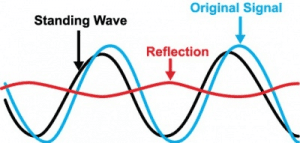Recently, we had a customer reach out to us inquiring about a 200 W L-band power amplifier (PA). While we did not have such an amplifier to offer (not yet, anyway), we did have a solution. That solution was four of our new L60T01 amplifiers in a hybrid configuration.
The concept of hybrid or balanced amplifiers is nothing new. Any solid state high power amplifier system on the market today is comprised of tens to hundreds of hybrid pairs. Even with the latest GaN technology, a single transistor is only capable of less than 1 kW of output power.
By combining many transistors in parallel, the maximum output power of an amplifier system is limited only by size of one’s wallet (and the power handling limits of the transmission lines, electrical power available, cooling capacity, etc. – physics gets you every time). If you ever have the opportunity to see a television station’s transmitter, you will find a couple 19” racks full of hybrid pairs, and an impressive liquid cooling system to keep the temperature under control.
However, it is not often that standalone commercial-off-the-shelf (COTS) amplifier modules are combined in hybrid configurations. Why? The first choice would be to use a single amplifier module with the output power required for the application. If physical size is not a critical parameter and budget allows, a rack-mount amplifier system is a great option.
Rack-mount amplifiers are typically outfitted with many bells-and-whistles that make them extremely versatile and robust amplifiers – think laboratory grade. Hybridized COTS modules are useful when rack-mount systems are too large, too costly, and there is no need for the added features. Additionally, when a single module is desired but such a module is not available with high enough output power for the application, combining two or more COTS modules is a good option to quickly implement an amplifier solution.
Our customer did not have the physical space or the budget for a rack-mount system, and only needed a straight-forward, turn-it-on-and-go PA solution. The solution was to combine four 60 W L60T01 modules. To reach our target of 200 W, we separated the four modules into two hybrid pairs providing over 100 W each. Those two hybrid pairs were then connected in hybrid to provide 200 W of output power. A diagram of the setup is shown in Figure 1.

There are also several benefits to using hybrid power combining in addition to increasing output power:
- Hybrids provide inherent VSWR mismatch protection. The energy reflected back to the PA from the mismatched load is routed to the isolated port of the hybrid coupler, and into a 50 Ω Thus, the amplifier system can handle a serious output mismatch (such as an open or short circuit) for as long as the 50 Ω termination is capable of dissipating the energy.
- Hybrid couplers provide a near perfect input and output impedance match to the amplifier module. For single-ended PA module designs this ensures top performance, and the module was designed for a 50 Ω
- Several amplifier modules in a hybrid combination also provide a means of graceful degradation. Each module is isolated by the hybrid coupler, and in the event of a failure, the remaining modules continue to function normally. The overall system output power will be reduced of course, but it will continue to operate until a repair can be made. For applications where “it just has to work” a hybrid system provides the necessary safety margin.

Figure 2 a Benchtop Prototype of the Four Pa Hybrid That Produced 200w of Output Power
Power combining with hybrids is a very effective method of increasing RF output power and implementing a hybrid system is a straight-forward process. Hybrid combining also inherently ruggedize the amplifier system by providing VSWR protection and a near-ideal impedance match to each PA module. For more information on hybrid coupled amplifiers and the details of the four PA hybrid described above, we will be releasing an Application Note on this topic in the near future. Stay tuned!
NuWaves RF Solitions has developed a wide variety of RF Power Amplifiers to support mission-critical CONOPS in telemetry, ISR, and tactical communication systems applications. Frequency ranges are available from VHF to C-Band. NuWaves also designs and fabricates custom RF Power Amplifiers to meet customers’ specific requirements. All RF Power Amplifier solutions are designed, built and tested in-house under NuWaves’ Quality Management System (QMS) certified to AS9100:2016 and ISO 9001-2015 standards, which ensures that each product arrives on-time and defect-free.
NuWaves also boasts a full suite of state-of-the-art design and simulation tools, test and measurement equipment, prototyping equipment and a full-scale production facility to provide custom solutions to your specifications. Contact NuWaves today to get the most out of your communication systems and advance your mission.


